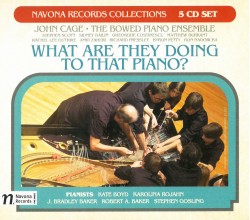 What Are They Doing To That Piano?
What Are They Doing To That Piano?
Kate Boyd; Karolina Rojahn; J. Bradley Baker; Robert A. Baker; Stephen Gosling
Navona Records NV6100 navonarecords.com
Compiling this boxed set to document the history of post-20th-century piano must have been somewhat of a challenge for producer Bob Lord and Navona Records. But vexed they were not, judging by the results of What Are They Doing to That Piano? This boxed set of works for prepared piano shows how far ahead of the contemporary classical music game Lord and his label really are. It is only fitting then that this compilation begins at the beginning, with a stellar recording of the music that began it all: John Cage’s Sonatas and Interludes. This cycle of pieces was written between 1946 and 1948, and together represents one of Cage’s major contributions to the music of the 20th century. This “prepared piano” cycle was created for an instrument invented out of necessity: unable to fit a percussion ensemble onstage to accompany a dance performance, Cage modified a piano to produce “a percussion ensemble controllable by one player.” Among modern pianists, Kate Boyd’s performance of Sonatas and Interludes remains a benchmark one, just as Greta Sultan’s recording of John Cage’s Études was before that.
In Sonatas and Interludes, Cage exploits a wide array of sonorities, some bright and bell-like, others more delicate and subdued. Rhythmic motifs and patterns recur, producing an incantatory and hypnotic quality close to that produced by the gamelan, the percussion orchestras of Java and Bali. As Cage himself suggested, “control” was key. And Kate Boyd appears to have mastered the markings on Cage’s vertical score with cultured musicality and fastidious pianism. This performance replaces brute power with pellucid textures and a kaleidoscope of brilliant colours. Grinding motoric rhythms are superseded by an infinitely calibrated kinaesthetic sense of terrifying intensity. Transitions of tempo occur with the natural inevitability of a living, breathing organism. The precise dimensions and shapes of Cage’s structures appear in sharp focus. Such wizardry continues unabated into In a Landscape as Cage’s musical narratives, for all their wealth of detail, unfold with undistracted purpose. In all of this, Boyd’s dazzling virtuosity is never an end in itself but the servant of her vivid imagination.
If Cage’s Sonatas and Interludes is the anthemic torchlight of the prepared piano, then Stephen Scott’s Ice & Fire is one of the most significant pieces in this ongoing relay of Olympian proportions. It is almost impossible to imagine the true extent of how tight a fit it must have been to accommodate ten players around the well of even a 9-foot grand piano. However, fit they not only did but also have brilliantly executed Scott’s music to a nicety. Afternoon of a Fire and Vocalise on “In a Silent Way” sit at opposite ends of the Scott-spectrum. The former work is framed around American Indigenous, music and the latter conjures the ghost of Miles Davis’ repertoire from the 1970s; a veritable Mecca for moderns. In these and the eight other pieces, the Bowed Piano Ensemble takes a leap, intellectually, musically and instinctually, as they match Stephen Scott’s invention and originality throughout.
Sidney Bailin’s pieces 16-2-60-N-5 develop from beguiling, elegant threads, which are sewn together by his electronic manipulations with Karolina Rojahn’s arresting pianism, evoking stimulating mental pictures of mysterious narratives. And while Rojahn reappears with J. Bradley and Robert A. Baker to deploy an astonishing array of colours on Felt, Stephen Gosling breathes luminosity into Gheorghe Costinescu’s music on An Evolving Cycle to complete this glorious 5-disc set. More than that, though, these “new” works themselves deserve wider performance lives beyond this beautiful beginning provided them by Lord and Navona Records.



